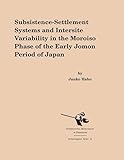Subsistence-Settlement Systems and Intersite Variability in the Moroiso Phase of the Early Jomon Period of Japan / Junko Habu.
Material type: TextSeries: International Monographs in Prehistory: Archaeological Series ; 14Publisher: New York ; Oxford : Berghahn Books, [2001]Copyright date: ©2001Description: 1 online resource (207 p.)Content type:
TextSeries: International Monographs in Prehistory: Archaeological Series ; 14Publisher: New York ; Oxford : Berghahn Books, [2001]Copyright date: ©2001Description: 1 online resource (207 p.)Content type: - 9781879621336
- 9781789201703
- 306.3/64/0952
- GN776.3.J6H23 2002
- online - DeGruyter
| Item type | Current library | Call number | URL | Status | Notes | Barcode | |
|---|---|---|---|---|---|---|---|
 eBook
eBook
|
Biblioteca "Angelicum" Pont. Univ. S.Tommaso d'Aquino Nuvola online | online - DeGruyter (Browse shelf(Opens below)) | Online access | Not for loan (Accesso limitato) | Accesso per gli utenti autorizzati / Access for authorized users | (dgr)9781789201703 |
Frontmatter -- Table of Contents -- List of Figures -- List of Tables -- Abstract -- Acknowledgments -- Chapter I. Introduction -- Chapter II. Theoretical Approach -- Chapter III. Background to the Study: The Jomon Period -- Chapter IV. Problems, Hypotheses, Materials and Methods -- Chapter V. Subsistence-Settlement Systems of the Moroiso Phase -- Chapter VI. Changes in Subsistence-Settlement Systems Through the Moroiso Phase -- Chapter VII. Discussion and Conclusions -- Tables -- References
restricted access online access with authorization star
http://purl.org/coar/access_right/c_16ec
This book examines the settlement patterns and intersite variability in lithic assemblages of Early Jomon (ca. 5000 BP) hunter-gatherers in Japan. A model is proposed that links regional settlement patterns and intersite lithic assemblage variability to residential mobility. The results of this study suggest that the Early Jomon people were not sedentary, as previously assumed, but instead moved their residential basis seasonally. The implications of this result are discussed in the context of the development of hunter-gatherer cultural complexity in general and the course of Japanese prehistory in particular.
Mode of access: Internet via World Wide Web.
In English.
Description based on online resource; title from PDF title page (publisher's Web site, viewed 25. Jun 2024)


